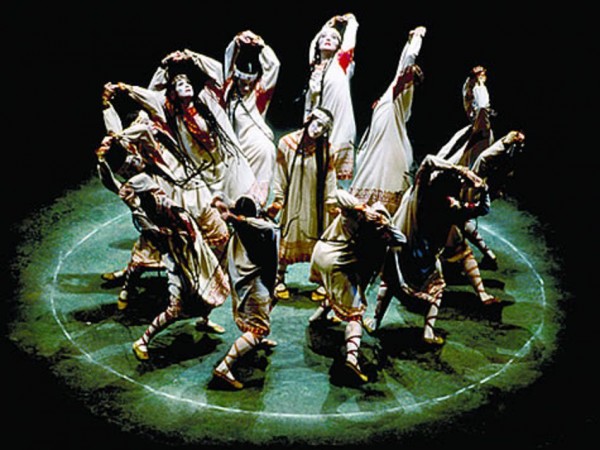
Joffrey Ballet teams up with the Cleveland Orchestra for full evening of music and dance at Blossom Music Center
At Blossom Music Center‘s outdoor amphitheater on August 17-18, the music and dance elephant in the room at was clearly the Joffrey Ballet’s reconstruction of “The Rite of Spring” (“Le Sacre du Printemps”). The ballet and music concert work was composed by Igor Stravinsky, commissioned back in 1913 for the Ballet Russes by Sergei Diaghilev, with original choreography by Vaslav Nijinsky.
Using the research efforts of lost choreography expert Millicent Hodson and Kenneth Archer, the Joffrey has reportedly been able to benefit from his costumes and decor studies to reconstruct and re-stage most of the original work as it was first performed to near riotous results in Paris.
The work was edgy back then. Stravinsky experimented with dissonance and unusual rhythms and the like, while Nijinsky pretty much started modern dance with his efforts. Audiences used to pretty and highly classical ballet were shocked (disoriented is probably a better word) and revolted by what they saw.
Looking at the ballet now, this is hard to imagine because it seems pretty tame by contemporary standards – even down to what seemed like way-overdressed dancers.
But it is a highly effective symbolic work about primitive rituals, like the choosing of a young woman as the “Other,” who, for the good of the group, dances herself to death.
In Joffrey’s hands, where the dancers are incredibly superb, the work holds. The company played (or danced) it to the hilt, all the while giving the audience a big taste of dance history.
In the first part of the concert, Joffrey performed another standout piece, Yuri Possokhov’s classically inspired “Adagio,” set to the music of Aram Khachaturian. The dancers, Victoria Jaiani and Temur Suluashvili, were incredible in their roles. The adagio is slow, as its musical term implies, and that makes great requirements on dancers to control their bodies and still seem fluid in their motions. Joffrey’s dancers were beguiling with the sureness of their technical and athletic abilities. The concluding embrace by the dancers was awesome.
For its opening concert work, Joffrey chose “Interplay,” a work created by famed American theater choreographer Jerome Robbins. As might be expected, the dance mixes classical ballet steps with modern quirky movements, much as can be seen in the movie “West Side Story.” In fact, in ensemble sections of this work – which is filled with playful interactions among the characters/dancers – you could see touches of dance reminiscent of the gym dance seen in that film. Hip, but controlled, jumpy, but classical.
The final work of the evening was Stanton Welch’s “Son of Chamber Symphony” (a musical work composed by John Adams). Not in a bad way, Welch plays dance games with classical style and repertoire. Ballerinas come out in what may seem old fashioned pancake tutus (as though performing in an elegant story ballet), yet the choreography sweeps them away from that vein and focuses on unusual and seemingly non-linear or narrative-driven movement.
The work seemed both familiar and oddly conceived in concert – which is probably the kind of reaction the choreographer was looking for. Tellingly, though, the Joffrey dancers were superb (a word that bears repeating when watching them).
Recent Content
-
Artsarticle ·
-
Artsarticle ·
-
Artsarticle ·
